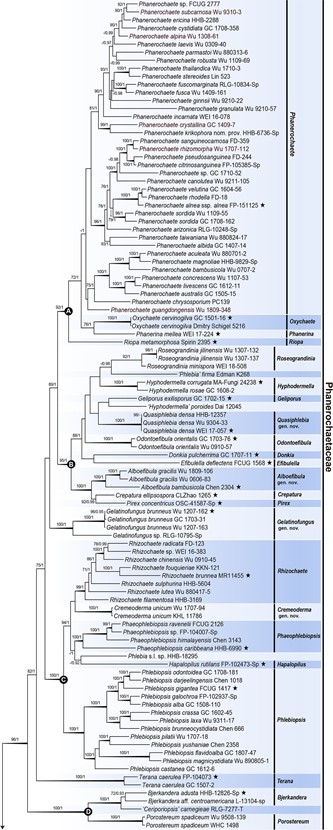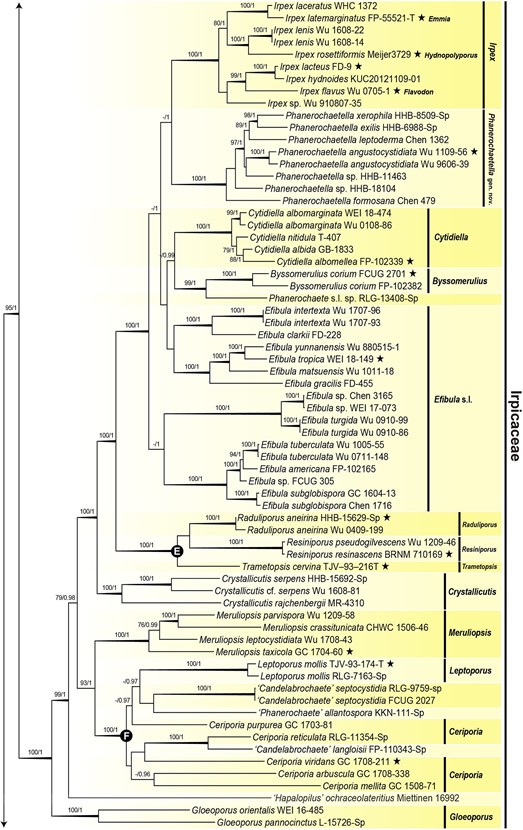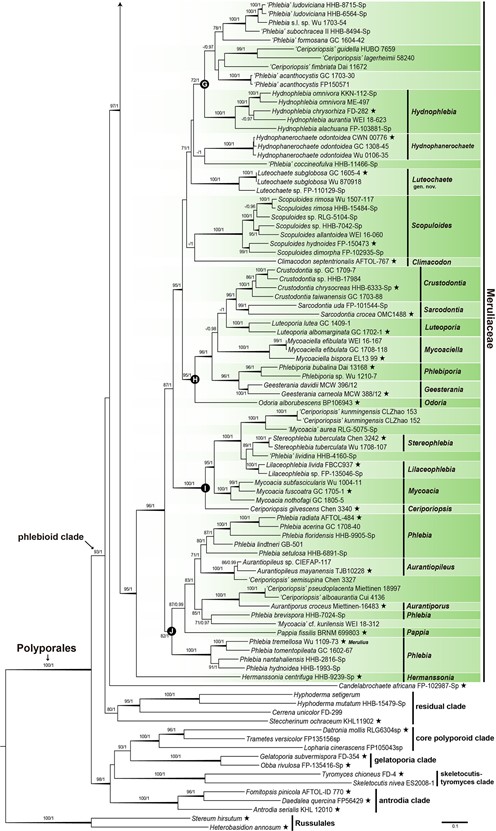Cremeoderma Sheng H. Wu & C.C. Chen, gen. nov. Fig. 10
MycoBank number: MB 840748; Index Fungorum number: IF 840748; Facesoffungi number: FoF;
Type species: Cremeoderma unicum.
Etymology: From creameo + derma, referring to the cream, effused basidiocarps of the type species.
Description: Basidiocarps annual, resupinate, effused, adnate, ceraceous to pruinose. Hymenial surface ivory white to cream, darkening in in KOH, smooth. Hyphal system monomitic; generative hyphae nodose-septate. Subiculum fairly uniform, with compact texture; hyphae colorless, agglutinated. Cystidia broadly obclavate, subfusiform or subulate, apically heavily encrusted, thick-walled (called lamprocystidia here). Cystidioles or hyphidia absent. Basidia clavate to cylindrical, thin-walled, 4-sterigmate. Basidiospores ellipsoid, colorless, thin-walled, smooth, inamyloid, nondextrinoid, acyanophilous. Causing a white rot on gymnosperm wood.
Notes: – In our analyses (Figs. 1, 4), the monotypic genus Cremeoderma was resolved as monophyletic with strong support within the Phlebiopsis lineage of Phanerochaetaceae. Cremeoderma is characterized by having effused, ceraceous to pruinose basidiocarps with smooth hymenophore, monomitic hyphal system with clamped hyphae, small, ellipsoid basidiospores, clavate to cylindrical basidia, and presence of lamprocystidia. General morphological characteristics of Cremeoderma, such as the monomitic hyphal system, clamped hyphae, clavate basidia and small basidiospores, are reminiscent of Phlebia s.l. However, hymenophore of Phlebia s.s. are usually merulioid, folded, or odontioid; besides, lamprocystidia are normally lacking in Phlebia s.s. Moreover, Phlebia s.s. is placed in Meruliaceae (Fig. 1). Cremeoderma also reminds in some aspects of Phlebiopsis, such as presence of projecting lamprocystidia and ellipsoid basidiospores, while the latter lacks clamp connections.

Fig. 1 The phylogram of the phlebioid clade (Phanerochaetaceae, Irpicaceae, Meruliaceae) of Polyporales inferred from ML analyses using the combined ITS + 28S + rpb1 + rpb2 + tef1 dataset. Branches are labelled with ML BS ≥ 70% and PP ≥ 0.9 from Bayesian analyses. Thicken branches indicated both ML BS ≥ 95% and PP ≥ 0.99 from Bayesian analyses. Line- ages labeled A–J represent the Phanerochaete, Donkia, Phlebiopsis, Bjerkandera, Trametopsis, Ceriporia, Hydnophlebia, Sarcodontia, Mycoacia and core Phlebia lineages, respectively. Black stars (★) represent for strains of generic type species. Bar = substitutions per site

Fig. 1 (Continued)

Fig. 1 (Continued)

Fig. 4 The phylogram of the Phlebiopsis lineage of Phanerochaetaceae inferred from ML analyses using the combined ITS + 28S data- set. Branches are labeled with ML bootstrap ≥ 70% and BPPs ≥ 0.9 from Bayesian analyses. New combinations or newly described taxa are shown in blue boxes. White stars (✰) represent for holotype or isotype. Black circles (●) represent for strains included in the 5-gene dataset. Sequences newly generated in this study were shown in bold. Bar = substitutions per site

Fig. 4 (continued)

Fig. 10 Basidiocarps of Cremeoderma unicum (Wu 1707-94) in general and detailed views. Bars = 10 mm
Species
